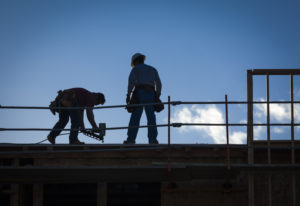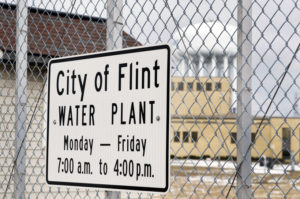The Right Way to Repair America’s Infrastructure
Last year, BlueGreen Alliance released our Making the Grade 2.0 report outlining how a robust investment in America’s infrastructure could create millions of quality jobs and protect the environment. We outlined three key elements to achieve that goal:
- A robust and broad public investment;
- Strong labor and procurement standards; and
- Forward-looking planning that delivers environmental benefits and builds resilient infrastructure systems.
Unfortunately, the infrastructure plan released this week by President Trump falls far short on all three counts. It passes the buck to states and local governments to carry the weight of investment, mentions little to assure workers that jobs created will be quality jobs, does not guarantee that projects will be required to use American products, and fails to consider the added strain climate change will put on our infrastructure in the future.
A Robust and Broad Public Investment
First, this infrastructure plan largely passes the buck to state and local governments and private entities to come up with the funds to make the infrastructure improvements our nation so desperately needs. But the truth of the matter is many state and local governments are already financially strapped and are struggling to provide for even the most basic of needs, like education. The federal government has been neglecting our nation’s infrastructure for too long, and the scope of the problem is too large to pass off to the states or cities that are already doing their fare share.
Moreover, Trump’s plan doesn’t actually provide any new funding at all—it’s simply a re-packaging of existing funding. This “new” infrastructure funding will be offset by cuts to things like transit funding and Transportation Investment Generating Economic Recovery (TIGER) grants—a successful grant program that allows the U.S. Department of Transportation to target investments across modes and regions where they will have the most impact.
A strong infrastructure package begins with a robust, public investment and must address the full scope of our infrastructure needs, including our buildings, electric grid, roads and transit systems, airports, water systems, and schools.
Strong Labor and Procurement Standards
 The president’s plan also does nothing to ensure that any jobs created by it would be good, family-sustaining jobs. Despite Trump’s pledge during the State of the Union that infrastructure improvements would be made with “American heart, American hands, and American grit,” his new plan fails to make a simple pledge that these improvements would be made with American products. Any infrastructure plan should include Buy American provisions that incentivize the use of American-made products and materials and, ultimately, spur domestic manufacturing.
The president’s plan also does nothing to ensure that any jobs created by it would be good, family-sustaining jobs. Despite Trump’s pledge during the State of the Union that infrastructure improvements would be made with “American heart, American hands, and American grit,” his new plan fails to make a simple pledge that these improvements would be made with American products. Any infrastructure plan should include Buy American provisions that incentivize the use of American-made products and materials and, ultimately, spur domestic manufacturing.
Repairing the nation’s infrastructure is a big job, and hard-working Americans will complete it. For an infrastructure plan to truly benefit American workers, it must include Davis-Bacon provisions—which ensure workers are paid prevailing wages on public works projects—and should use project labor agreements and community benefits agreements that can help ensure projects are completed effectively and on time, that communities and workers have a voice in project development, that people in low-income communities and communities of color have the opportunity to get these jobs, and that returns on investment are maximized in the communities where these projects occur.
Not only does the infrastructure plan released this week offer no assurance that policies like Buy American and Davis-Bacon will be included, it actually proposes a number of exemptions that could weaken these critical protections—shifting funding for projects away from the federal government and creating potential loopholes around existing requirements.
A strong infrastructure package begins with a robust, public investment and must address the full scope of our infrastructure needs, including our buildings, electric grid, roads and transit systems, airports, water systems, and schools.
Forward-looking Planning & Resilient Infrastructure Systems
Finally, a modern infrastructure system should be built with the future in mind. Last year’s historic storm season devastated communities in Texas, Florida, Puerto Rico, and the U.S. Virgin Islands. Wildfires are tearing through the West, and our nation’s coasts are shrinking. Yet the President’s plan does not make the connection between these impacts and how we should be investing in our communities. It does us no good to repair our infrastructure systems if they’re only going to be destroyed again in months or years as stronger storms and severe weather impacts from climate change continue to grow.
To safeguard our investment and ensure our communities are more resilient moving forward, we need to build and rebuild in a climate-smart way. Any infrastructure package should follow processes that ensure effective environmental review and public participation in infrastructure decisions while also prioritizing the resources needed to ensure these projects move forward swiftly and deliver benefits to communities and workers quickly.
The Bottom Line
 Ultimately, we need an infrastructure plan developed with the best interests of American workers and communities in mind, and we need it soon. Congressional Democrats in both chambers released infrastructure plans that achieve our three goals: they put real federal dollars—$1 trillion to be exact—on the table and prioritize the kinds of policies, including Davis Bacon and Buy America, that maximize benefits to workers and communities. Plans like these will ensure our infrastructure will be built to last, jobs created can sustain a family and boost local economies, and the systems we rely on every day are safer, cleaner, and more efficient.
Ultimately, we need an infrastructure plan developed with the best interests of American workers and communities in mind, and we need it soon. Congressional Democrats in both chambers released infrastructure plans that achieve our three goals: they put real federal dollars—$1 trillion to be exact—on the table and prioritize the kinds of policies, including Davis Bacon and Buy America, that maximize benefits to workers and communities. Plans like these will ensure our infrastructure will be built to last, jobs created can sustain a family and boost local economies, and the systems we rely on every day are safer, cleaner, and more efficient.
Unfortunately, that is not the plan President Trump released. The difference between the proposals is more than just money; it’s fixing water systems to avoid the lead poisoning we saw in Flint, Michigan; repairing your local bridges to prevent them from falling apart; stopping transit systems from breaking down and stranding riders; knowing our children are learning in healthy schools; and having our infrastructure systems ready for the next Hurricane Harvey, Irma, or Maria.
It’s what America needs.